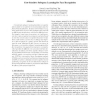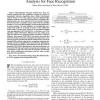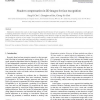89
Voted
CVPR
2010
IEEE
14 years 11 months ago
2010
IEEE
Conventional subspace learning-based face recognition aims to attain low recognition errors and assumes same loss from all misclassifications. In many real-world face recognition...
125
Voted
TSMC
2008
15 years 1 days ago
2008
Abstract--Dimensionality reduction methods have been successfully employed for face recognition. Among the various dimensionality reduction algorithms, linear (Fisher) discriminant...
124
Voted
PRL
2007
15 years 3 days ago
2007
Two-dimensional principal component analysis (2DPCA) is based on the 2D images rather than 1D vectorized images like PCA, which is a classical feature extraction technique in face...
115
Voted
PRL
2007
15 years 3 days ago
2007
Government agencies are investing a considerable amount of resources into improving security systems as result of recent terrorist events that dangerously exposed flaws and weakn...
119
Voted
PR
2007
15 years 3 days ago
2007
Illumination variation that occurs on face images degrades the performance of face recognition. In this paper, we propose a novel approach to handling illumination variation for f...
105
Voted
PR
2007
15 years 3 days ago
2007
Detecting faces in images is a key step in numerous computer vision applications, such as face recognition or facial expression analysis. Automatic face detection is a difficult ...
108
Voted
PR
2007
15 years 3 days ago
2007
Face recognition is a challenging task in computer vision and pattern recognition. It is well-known that obtaining a low-dimensional feature representation with enhanced discrimin...
108
click to vote
PR
2007
15 years 3 days ago
2007
Feature extraction is among the most important problems in face recognition systems. In this paper, we propose an enhanced kernel discriminant analysis (KDA) algorithm called kern...
107
Voted
CORR
2010
Springer
15 years 5 days ago
2010
Springer
Artificial neural networks have already shown their success in face recognition and similar complex pattern recognition tasks. However, a major disadvantage of the technique is th...
91
Voted
PR
2002
15 years 8 days ago
2002
This paper presents an e cient automatic face recognition scheme useful for video indexing applications. In particular7 the following problem is addressed: given a set of known fa...






